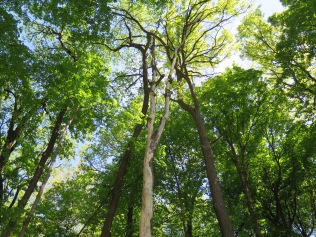Morel Mushroom Hunting in the Twin Cities

Hello Friends,
It seems Minneapolis/St. Paul has really come to life in the last three weeks. While walking around my neighborhood, I could smell the difference. The lilac bushes began to bloom a few weeks ago, releasing it’s wonderfully fragrant flowers. The spruce trees, which are generally sharp to the touch, have grown their new soft needles. The new growth releases a sweet, conifer kind of smell. And let’s not forget the smell of freshly cut grass.
As for what I have been up to, these last two weeks have been filled with outdoor activities. When I get off work or have a free weekend, I’m outside either gardening, walking, playing frisbee, or searching for mushrooms. Well, not any kind of mushroom, the morel mushroom!

Morel Mushroom Hunting in the Twin Cities
Before talking about my experiences morel hunting and how to find morels, I want to preface that I’m an amateur mushroom seeker. This is my first season in Minnesota and my third season overall because I went mushrooming twice while living in Oregon.
My friend, Jim, and I have gone out three times to seek for morel mushrooms. The first two times, we were in the Minnesota River Valley area, and the third time, we were in the Dakota County area. The images in this post are from our adventures in Dakota County.
While hiking through woodland forest, steep ravines, and colorful, wildflower-filled lowland floodplain, I’ve learned a bit about where to look and what to look for while morel mushroom hunting. This is not to say that this will work every time. Jim prefaced to me that you may find the most perfect place for a morel and for some reason, there will be no morel to be found. Morels can be fickle and may not be there. They are still a mystery.
Here are a few tips for the amateur morel hunter.
- Morels like to grow near dead elm trees, especially recently dead ones. In the photos above are two different elm trees. The photo to the right shows an old dead tree that wouldn’t have morels, but the photo shows the tree’s structure. The left photo is a close-up of the bark of a recently dead tree. You can tell it’s an elm in this photo because of the bark texture, as well as the way the bark peels off in patches. This is where you would have a high chance of finding a morel mushroom.

- I’ve noticed that all the morel mushrooms we have found seem to be on south-facing slopes (except for a couple that we found in a dry, lowland floodplain). I assume the light and heat from the sun help the morel mushrooms, but again morels are a mystery because you may find morels in a north-facing slope. Here is an image of Jim walking up a south-facing slope, keeping an eye out for dead elm trees.

- And lastly, this is what a morel mushroom looks like. Some are more gray, while others are more brownish-yellow. With a knife, cut a quarter-inch above where the morel mushroom base reaches the soil (to avoid getting dirt, as well as to leave a part of the fruiting body in the soil). Then place in a mesh bag or whatever handheld bag you brought along (do not place in a backpack where the mushrooms could get squished). The true morels are hollow on the inside. If you find a mushroom that looks kinda like a morel, but you worry that you’ve picked the false morel mushroom (Gyromitra esculenta), then simply make a longitudinal cut from head to base. If the mushroom is hollow, then it’s a morel; if the mushroom is meaty and not hollow, then it’s the false morel!

Here is an image of two ferns: Lady Fern (I believe) and Maidenhair Fern. If you’re hiking and you start seeing a bunch of ferns, then you’re most likely on a north-facing slope. Morels may be around, but not as likely as on a south-facing slope.

Me wearing my hiking outfit
If you find yourself bushwhacking, make sure to wear the appropriate clothing (long pants tucked into socks, sturdy hiking boots, and a long sleeve shirt). Jim and I saw poison ivy while hiking—and you never know where there might be wild parsnip. Also, I wear clothes that I sprayed with anti-tick chemicals. It isn’t necessary, but I would highly encourage it if you are hiking on deer trails or in grasslands. There is also anti-insect treated clothing that you can buy at any outdoor store.
Morel hunting is a fun hobby and the best part is that they can be found almost anywhere, even in your backyard. With the knowledge you’ve learned in this post, I’d encourage you to explore your backyard or local park to see if you can find any morel mushrooms. They may be past season in southern Minnesota, so anywhere near the Twin Cities and north of that is probably fair game!
Good luck!

Our bounty!
Much love,
-Molly




That looks so great! I can’t believe you found so many! Next year we definitely will join you!!!
LikeLike
Pingback: A 2020 and 2021 Review and Check Out The Coco Canary Newsletter To Keep Up With What I am Up To | Molly's Journey to the West